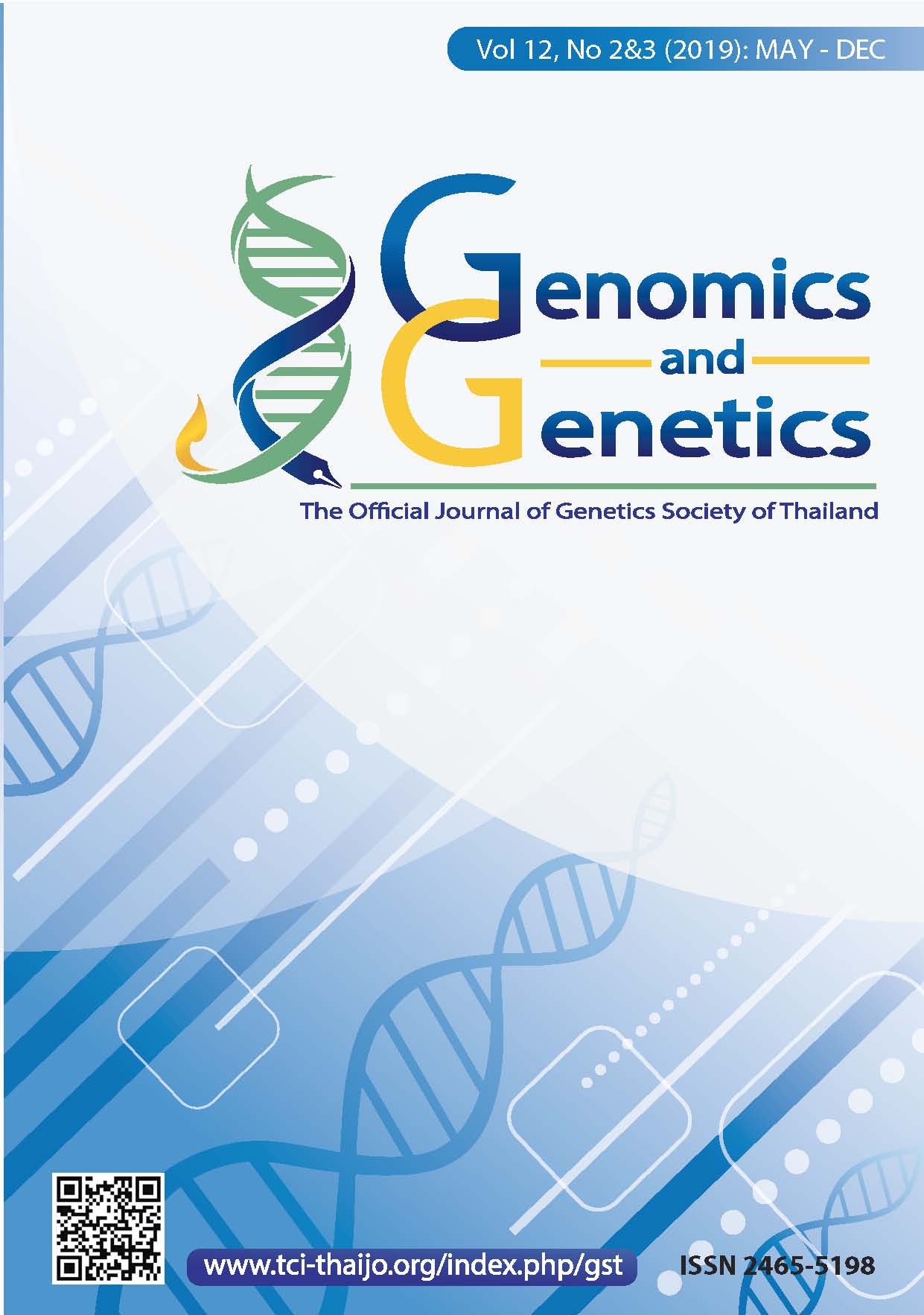Difference in defense mechanism of two cassava cultivars to bacterial blight disease inferred by analysis of interspecies protein-protein interaction networks
DOI:
https://doi.org/10.14456/gag.2019.6Keywords:
cassava; Manihot esculenta Crantz; protein-protein interaction; Xanthomonas axonopodisAbstract
Cassava (Manihot esculenta Crantz), is an important economic crop of the world and especially Thailand. One of the major problems resulting in its yield loss is cassava bacterial blight (CBB) disease caused by Xanthomonas axonopodis (XAM). Unfortunately, the basic knowledge of cultivar-specific defense mechanism is limited. Therefore, in this work protein-protein interaction (PPI) networks of two cassava cultivars; KU50 and AM560, and XAM were reconstructed using domain-domain interaction method (DDI) to study interactions between XAM and cassava. The PPIXAM-KU50 consisted of 24,509 interactions from 4,754 proteins while PPIXAM-AM560 contained 28,962 interactions from 6,153 proteins. The results demonstrated that XAM used different mechanisms to invade specific cassava cultivar. This study would enable us to comprehend the protein-protein relationship between bacterial pathogen and cassava.
References
Berr A, McCallum EJ, Alioua A, Heintz D, Heitz T, Shen WH (2010) Arabidopsis histone methyltransferase set domain group8 mediates induction of the jasmonate/ethylene pathway genes in plant defense response to necrotrophic fungi, Plant Physiology, 154(3): 1403–1414.
Bhate MP, Molnar KS, Goulian M, DeGrado WF (2015) Signal transduction in histidine kinases: insights from new structures, Structure, 23(6): 981–994.
Bishop J, Dean AM, Mitchell-Olds T (2000) Rapid evolution in plant chitinases: molecular targets of selection in plant-pathogen coevolution, Proceedings of the National Academy of Sciences, 97(10): 5322–5327.
Bock K, Woods R (1983) Etiology of African cassava mosaic disease, Plant Disease, 67(9): 994–995
Chimento DP, Mohanty AK, Kadner RJ, WienerM.C (2003) Substrate-induced transmembrane signaling in the cobalamin transporter btub, Nature Structural and Molecular Biology, 10(5): 394.
Du Z, Zhou X, Ling Y, Zhang Z, Su Z (2010) Agrigo: a GO analysis toolkit for the agricultural community, Nucleic Acids Research, 38: W64–W70.
Dutt N, Briddon R, Dasgupta I (2005) Identification of a second begomovirus, Srilankan cassava mosaic virus, causing cassava mosaic disease in India, Archives of Virology, 150(10): 2101–2108.
FAO (2013) Save and Grow: Cassava Sustainable Production Intensification, Rome, pp.121–128.
FAO (2015) Food Outlook: Biannual Report on Global Food Markets. FAO, Rome, pp. 1–133.
Finn RD, Bateman A, Clements J, Coggill P, Eberhardt RY, Eddy SR, Heger A, Hetherington K, Holm L, Mistry J (2013) Pfam: the protein families database, Nucleic Acids Research, 42(D1): D222–D230.
Finn RD, Miller BL, Clements J, Bateman A (2014) Ipfam: a database of protein family and domain interactions found in the protein data bank, Nucleic Acids Research, 42(D1): D364–D373.
Goodstein DM, Shu S, Howson R, Neupane R, Hayes RD, Fazo J, Mitros T, Dirks W, Hellsten U, Putnam N (2012) Phytozome: a comparative platform for green plant genomics, Nucleic Acids Research, 40(D1): D1178–D1186.
Hoffmann H, Schiene-Fischer C (2014) Functional aspects of extracellular cyclophilins, Biological Chemistry, 395(7): 721–735.
Jehl MA, Arnold R, Rattei T (2010) Effective-a database of predicted secreted bacterial proteins, Nucleic Acids Research, 39: D591–D595.
Jia,Y, McAdams SA, Bryan GT, Hershey HP, Valent B (2000) Direct interaction of resistance gene and avirulence gene products confers rice blast resistance, The EMBO Journal, 19(15): 4004–4014.
Kromina K, Ignatov A, Abdeeva I (2008) Role of peptidyl-prolyl-cis/trans-isomerases in pathologic processes, Biochemistry Supplement Series A: Membrane and Cell Biology, 2(3): 195–202.
Li J, Wang N (2011) Genome-wide mutagenesis of Xanthomonas axonopodis pv. citri reveals novel genetic determinants and regulation mechanisms of biofilm formation, PLoS One, 6(7): e21804.
Li ZG, He F, Zhang Z, Peng YL (2012) Prediction of protein–protein interactions between Ralstonia solanacearum and Arabidopsis thaliana, Amino Acids, 42: 2363–2371.
Lozano JC (1986) Cassava bacterial blight: a manageable disease, Plant Disease, 70(12):1989–1993.
Marshall SD, Putterill JJ, Plummer KM, Newcomb RD (2003) The carboxylesterase gene family from Arabidopsis thaliana, Journal of Molecular Evolution, 57: 487–500.
Salanoubat M, Genin S, Artiguenave F, Gouzy J, Mangenot S, Arlat M, Billault A, Brottier P, Camus JC, Cattolico L, Chandler M (2002) Genome sequence of the plant pathogen Ralstonia solanacearum. Nature, Vol. 415(6871): 497.
Scofield SR, Tobias CM, Rathjen JP, Chang JH, Lavelle DT, Michelmore RW, Staskawicz BJ (1996) Molecular basis of gene-for-gene specificity in bacterial speck disease of tomato, Science, 274(5295): 2063–2065.
Supek F, Bošnjak M, Škunca N, Šmuc T (2011) Revigo summarizes and visualizes long lists of gene ontology terms, PloS One, 6(7): e21800.
Wang W, Feng B, Xiao J, Xia Z, Zhou X, Li P, Zhang W, Wang Y, Moller BL, Zhang P (2014) Cassava genome from a wild ancestor to cultivated varieties, Nature Communications, 5:5110.
Zhang K, Li Y, Li T, Li ZG, Hsiang T, Zhang Z, Sun W (2017) Pathogenicity genes in Ustilaginoidea virens revealed by a predicted protein–protein interaction network, Journal of Proteome Research, 16(3): 1193–1206.



